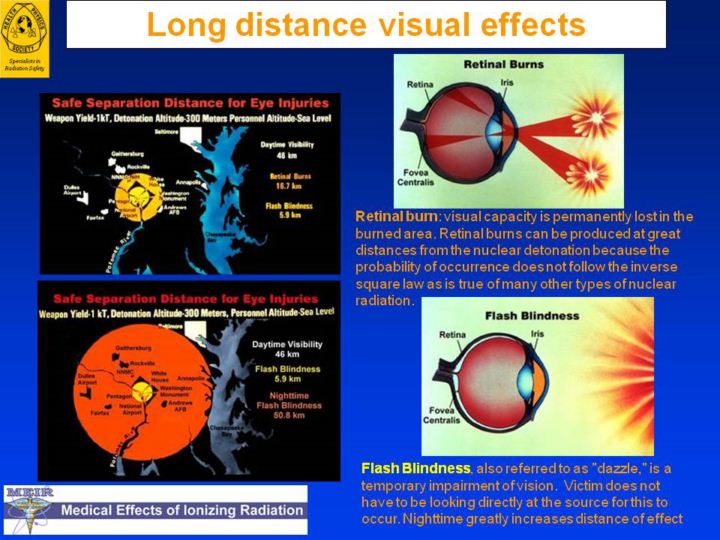| front |1 |2 |3 |4 |5 |6 |7 |8 |9 |10 |11 |12 |13 |14 |15 |16 |17 |18 |19 |20 |21 |22 |23 |24 |25 |26 |27 |28 |29 |30 |31 |32 |33 |34 |35 |36 |37 |38 |39 |40 |41 |42 |43 |44 |45 |46 |47 |48 |review |
 |
Eye injuries. Ultraviolet radiation primarily is responsible for eye injuries, which can be transient, like flash blindness, or permanent, like retinal burns. Flash blindness is the most common eye injury, but ultraviolet radiation can cause retinal burns if a person looks directly at the explosion.
Flash blindness. Flash blindness, also referred to as "dazzle," is a temporary impairment of vision caused by a bleaching of the rods and cones in the retina. It can be produced by scattered light and does not necessarily require the eye to be focused on the light source, the fireball in the case of a nuclear detonation. Flash blindness usually blanks out the entire field of vision with a bright afterimage. Fortunately, the effects are temporary, and complete recovery occurs within a short time.
Retinal burns. A retinal burn is a permanent injury that occurs when the retinal tissue is heated excessively by an extremely bright image, the fireball in this case. The underlying pigmented cells absorb much of the light (radiation) energy, and the temperature is increased in that area. A temperature elevation of 12 ÉC to 20 ÉC in the eye will produce a thermal injury that involves both the pigmented layer and the adjacent rods and cones. Thus, visual capacity is permanently lost in the burned area. The natural tendency of people to look at a fireball increases the chance of retinal burns. Also worthy of note is that retinal burns can be produced at great distances from the nuclear detonation because the probability of occurrence does not follow the inverse square law as is true of many other types of nuclear radiation. Protection against thermal radiation . Thermal radiation travels at the speed of light. So, unless you have adequate forewarning, there is little you can do to protect yourself from injury. If provided advance warning, any light-impermeable object provides adequate protection from direct exposure since electromagnetic radiation waves travel in a straight line. Protective barriers might include hills, buildings, tanks, bunkers, and trees. Loose-fitting, light-colored clothing provides a degree of protection because of the insulating layer of air between the clothing and the skin and because it reflects some of the thermal radiation. |